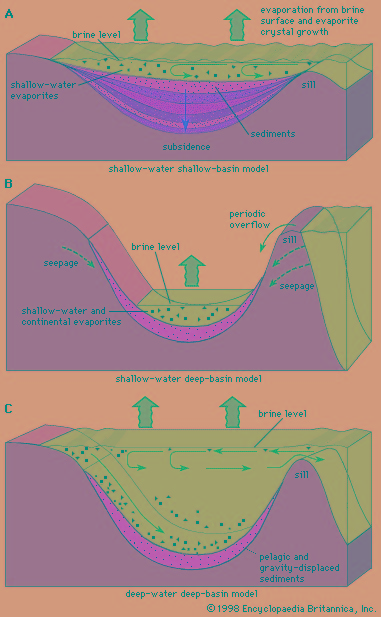evaporite
geology
 any of a variety of individual minerals found in the sedimentary deposit of soluble salts that results from the evaporation of water.
any of a variety of individual minerals found in the sedimentary deposit of soluble salts that results from the evaporation of water.A brief treatment of evaporite deposits and their constituent minerals follows. For full treatment, see sedimentary rock: Evaporites (sedimentary rock).
Typically, evaporite deposits occur in closed marine basins where evaporation exceeds inflow. The deposits often show a repeated sequence of minerals, indicating cyclic conditions with a mineralogy determined by solubility. The most important minerals and the sequence in which they form include calcite, gypsum, anhydrite, halite, polyhalite, and lastly potassium and magnesium salts such as sylvite, carnallite, kainite, and kieserite; anhydrite and halite dominate. These sequences have been reproduced in laboratory experiments and, therefore, the physical and chemical conditions for evaporite formation are well known.
In contrast to basin deposits, extensive thin-shelf deposits are known and are thought to be the result of shallow, ephemeral seas. Non-marine evaporites formed by streams flowing into closed depressions, especially in arid regions, give rise to deposits of borates, nitrates, and sodium carbonates. Such deposits occur in Utah and southern California in the United States.
- audiencia
- Audion
- audiovisual education
- auditing
- auditorium
- Audley, Thomas Audley, Baron
- Audouin Dollfus
- Audra McDonald
- Audre Lorde
- Audrey Hepburn
- Audrey I. Richards
- Audrey Tautou
- Audrey Thomas
- Audubon, John James
- Auenbrugger von Auenbrugg, Leopold
- Auerbach, Berthold
- Auerbach, Erich
- Auerbach, Red
- Auer, Leopold
- Auersperg, Adolf, Prince von, Duke Von Gottschee
- Auersperg, Johann Weikhart, Prince von
- Aufbau principle
- Aufklärung
- Aug. 4, 1914 Land forces of the belligerents
- Aug. 4, 1914 Strength of the Belligerents